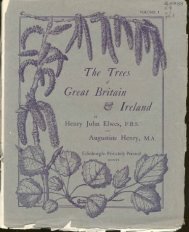THE METAMORPHOSES OF PUBLIUS OVIDIUS NASO
THE METAMORPHOSES OF PUBLIUS OVIDIUS NASO
THE METAMORPHOSES OF PUBLIUS OVIDIUS NASO
You also want an ePaper? Increase the reach of your titles
YUMPU automatically turns print PDFs into web optimized ePapers that Google loves.
FABULA V.<br />
CADMUS ET HERMIONE IN DRACONES.<br />
Cadmus and Hermione, affected by the calamities that had happened to theij<br />
family, abandon Thebes and go into Ulyricum. Here he suspects that his<br />
afflictions have been in consequence of the dragon which he slew being<br />
sacred to some god; after which he and his wife are changed to serpents.<br />
EXPLICATIO.<br />
As some learned men contend that Cadmus was a real personage, in<br />
accordance with that view, and for the sake of heroic interest, we regarded<br />
him as an historical character, in our explanations of Fables I. and II.<br />
Book HI. But the achievements of Cadmus could not have been the<br />
work of tin individual, for he is said to have led colonies into Phenicia,<br />
Cyprus, llhodcs, Thera, Thasus, Anape, and Samothracia ; to have dis<br />
covered and have wrought mines of gold and copper in Cyprus and else<br />
where ; to have founded settlements, and one hundred cities in Africa:<br />
to have established colonies in Attica, Euboea, Boeotia, and Illyrin; to have<br />
reigned in Armenia, and, after reigning at Thebes for sixty-two years, to<br />
have reigned in Illyria. Besides this, he is said to have been tne in<br />
ventor of letters.<br />
Now, all these things may be referred to a tribe, but could not have<br />
been the work of an individual. We will, therefore, regard Cadmus,<br />
(anciently written KdSfi^v,) not as a real character, but a personification<br />
of the Cadmonites, a race spoken of in the Bible, who lived near Baal<br />
Hermon, in Syria. On this account, and probably beraijse a body of<br />
Hermonians accompanied the Cadmonites to Boeotia, Hermione is alle-<br />
gorically the wife of Cadmus. The people around Baai Hennon were<br />
given to serpent-worship, and in consequence were called Hivites, from<br />
Hivia,« serpent. Ancient authors say, that in Hermon and Alount Libanus<br />
were many Batrvjua (Beth-el, house of God); these were the upright<br />
stones that formed the serpent-temples. Hence, Cadmus, who is de<br />
scribed as identical with the Taut* of the Phenicians, the Thouth of the<br />
Egyptians, and the Hermes of the Greeks, is said to have taught the<br />
worshipt of the serpent, and at last to have been changed into a serpent.<br />
As the temples used by the worshippers of the serpent were built of up<br />
right stones, disposed in the form of that reptile, it is a myth of easy ap<br />
plication to say that Cadmus was changed into a serpent. As Scinele<br />
(Sema-el, the token of God, i. e. the Rainbow), and Ino (lone, the dove],<br />
are daughters of Cadmus; and Bacchus (Noah) his grandson, it is readily<br />
perceived, that Cadmus (the Cadmonites) brought the traditions of the<br />
Deluge into Greece: as also the tradition of the serpent of Paradise,<br />
which, at first regarded as oracular, became a symbol a talisman and<br />
at length a god through the nations.<br />
* Tani is Hie firs! lhal invented letters—whom the Egyptians called Tliouth, ihe Alexandrians<br />
Tholh. but the Orceka rendered Hermes—Pmr.o ATOD L.USEBIUM.<br />
Cmlinus. ncit only a royiil epithet, liul tin epithet of Hermes.—VETUS AUCTOR APUD PIIAVORIM.M<br />
Cadmus, who is Ihe same as Hermes. SCHOUAST ON IACOPIIRON".<br />
t Tiuil consecrated the Jbrm of Ihe dragon and ofserpenls; and the P!ienici»"s and Egyptians<br />
after him dtil the snme.—EUSKBIUS, I'K.BH. EVANG., Iiib. i.. Cap. 10.<br />
The Greeks received Hie worship of Hie serpent from Ciclums.—Vosstus.<br />
286<br />
ESCIT Agenondes natam parvumque nepotem<br />
TEquoris esse deos. Luctu seneque malorum<br />
Victus, et ostentis, qua plurima viderat, exit<br />
Conditor urbe sua; tanquam fortuna locorum<br />
Non sua se premeret: longisque erratibus actus<br />
Contigit Illyricos profuga cum conjuge fines.<br />
Jamque malis annisquc graves, dum prima retractant<br />
Fata domfis, relcguntque sues sermone labores;<br />
Nuin sacer ille mca tntjectus cuspide serpens,<br />
Cadmus ait, fuerit: turn, ciini Sidone profectus<br />
Vipereos sparsi per hmnum, nova semina, denies?<br />
ducin si cura defim tain certa vindicat ira,<br />
Ipse precor scrpcns in longam porri«;ar alvum.<br />
Divit; et, ut serpens, in longam tenditur alvum:<br />
Duratasque cuti squamas increscere sentit,<br />
1. Agenoridrs. Cadmus, the son of<br />
Ape nor.<br />
4. Urtiffua. From Thebes, which he<br />
had founded.<br />
6. lllyricns. Illyriemn, now Upper .Al<br />
bania, v, as n count ry of Greece, the precise<br />
limits 'if which nre not known. It was<br />
bounded on tlie ejsM by a ratiw of moun<br />
tains that sep.ir.ites it from Tlicwwily; on<br />
the roulli by F.pirus. now Lower Aflmiiin;<br />
and on the west by Marc Harjiiaticuin.<br />
7. Malis iinnisuue p*aves: weighed<br />
down with misfortunes nnd with years.<br />
"\Vhen ape ami waul, O ill-nxilcheil pair.<br />
Show man w is made to mourn.—BIBXS.<br />
10<br />
15<br />
9. nif trrpmt. The srrpenl which he<br />
hnd sl.iin, as related in Lib. III., Fab. I.<br />
12. Vhnli-al. Cadmus is led to suppose<br />
that I he mNfiirl tines which he has suffered,<br />
have been inflicted by some deity, to whom<br />
llic serpent which he slew was sncred.<br />
13 Ijiftr fcrjieny porriftar: m ay I myself<br />
be extended, n pcrpcnl. The ophite<br />
liicrogriiin is found wherever ihc scrpcnt-<br />
worship prevailed. It appears on coins,<br />
medals, temples, and pillars, undrr vnriotta<br />
modifications, as shown in Figures 1 to 7.<br />
The fcrpent of Paradise was the original<br />
of the whole. See note on Serpentis,<br />
page 92.<br />
287













